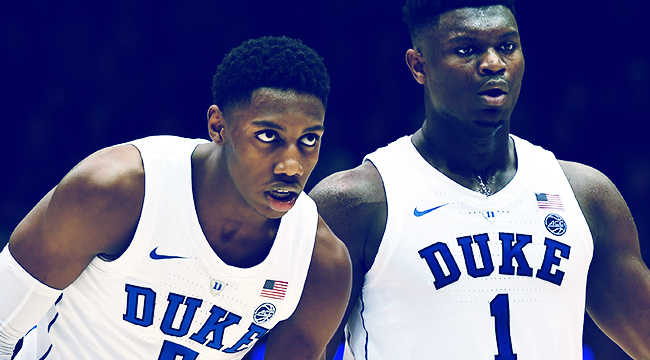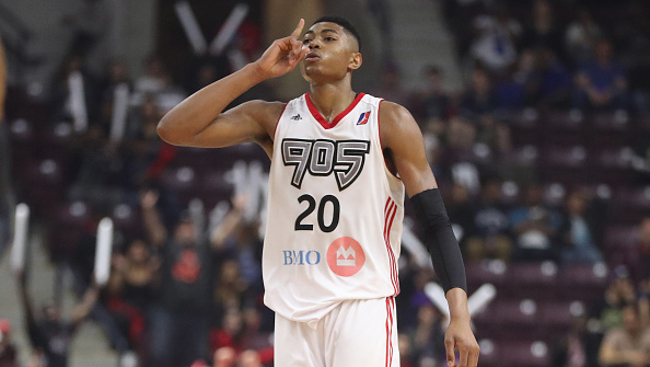
The NBA community has the same discussions about the draft, one-and-done rule, and the issue of tanking every single year. The league has instituted new draft lottery reforms that will go into effect this summer, with odds smoothing to lessen the reward for having the worst record in an effort to get teams to try harder and not tank — the teams with the three-worst records all have a 14 percent chance at the top pick.
That may have worked to an extent, as teams like the Hawks and Bulls have been more competitive recently, possibly due to not feeling as pressured to chase after the worst record in the league. Still, teams like the Knicks and Suns are abysmal and, so long as the lottery exists, there will be incentive to have a worse record.
On top of the ever-present tanking discussion, the one-and-done rule is soon to be done away with, as the league has filed an official proposal to begin negotiations with the NBPA to roll the age limit back from 19 to 18 by the 2022 draft. That’s a step in the right direction to allow players that are clearly NBA prospects to enter the league immediately out of high school rather than having to delay getting paid for their skills.
Still, there are those that aren’t keen on lowering the age limit. The strongest argument on the side of forcing kids to go to college is that most players coming straight out of high school aren’t physically or mentally prepared for life as a professional. NBA teams like having what is, in essence, a free development program for young players at the collegiate level, but there’s a significant issue there as well.
The vast majority of college basketball programs rightly aren’t in the business of trying to get players ready for the NBA. They’re trying to win, which means playing a style of ball that doesn’t mirror what NBA teams play. Because of that, some players still have to wait to develop NBA skills until they’re in the Association — an example of this is Syracuse players who are not asked to play man-to-man defense in college.
The fault here is on the system that doesn’t give players the best chance to develop the skills they need to display at the professional level. The fix for this is to completely do away with the current model, taking a cue from a European sports model where professional teams operate youth academies that develop players internally from a young age.

Now, rather than each team owning and operating its own academy (which would inevitably create a greater divide between the Haves and Have Nots in the league), my idea is to create an NBA Youth Academy, funded by all 30 teams and/or a TV contract to broadcast Academy games.
Mavs owner Mark Cuban recently discussed the current system of youth development system for young basketball players in America, praising the European model after landing a star rookie in Luka Doncic. Cuban, somewhat rightly, received a ton of pushback, because while Doncic is a star, historically the best players have still come from the States. However, there is a legitimate case to be made that American players come into the NBA needing significant development, and the way to fix that would be to get teenage prospects playing a professional style and learning NBA-type skills at a much earlier age.
Here’s how it would work. The NBA would create an accredited private high school, with each team having the same number of scholarships to give out to kids from grades 9-12 (let’s say 30, enough to fill a JV and Varsity squad each, so 900 total students in the school). The students would all go to classes together — with some electives tailored to the needs of NBA players, like courses offered on life skills — and graduate with a high school diploma that, should they not end up making it to the NBA, would still allow them to go off to college.
Scholarships would be guaranteed through graduation, to keep teams from just firing off scholarships to freshmen and sophomores, only to cut them quickly if they don’t grow or develop as planned. That protects the kids and further encourages responsible scouting and development from the teams. The scholarships can only be given out in the summer, bringing new kids in prior to the start of the school year and after the end of the previous school year.
Each team would have its own facility attached to housing for their group of 30 students, where they could control everything from a training to nutrition. Teams would develop NBA skills in players, run NBA offenses and defenses, and just generally ask them to do things they’ll need to do at the professional level and nothing else.
In theory, this would create young players that would be actually NBA ready upon entering the league, both from a physical development standpoint, having been with professional trainers from a high school age, and from understanding NBA offense and defense. Teams would all play each other on campus, creating a centralized scouting location for teams and keeping players from having to deal with the travel demands of either a high school or AAU schedule.
Now, given that each team would be tasked with bringing in its own talent, as part of the Academy, the league would get rid of the NBA Draft. Instead, players would become restricted free agents upon graduation, with rights possessed by the team they played for at the Academy. Rather than the current rookie scale dictating what they make based on draft slot, there would be a rookie max (let’s say 4/40, for a nice round number) and teams would be rewarded for finding and developing their own young talent by having the opportunity to sign their best players.
This allows more players to maximize their earning potential on their rookie deal rather then being locked into a slot value, as well as taking away any incentive for teams to tank and lose because the way you bring in young talent is to bring them in at the Academy level and develop them — or be willing to overspend for young talent that hasn’t been maximized by another team.

Because there would be far more graduating members of the Academy than open roster spots in the NBA, it would be imperative to be honest with the players as they go along. Rather than the draft board that offers players an idea of where they stand as prospects for the draft, starting in their junior year, players can meet with a scouting board that would give players an idea of whether they are going to be signed on the free agent market once graduated (and an approximate value), or if they should pursue the G League, college, or overseas options.
The G League could be expanded to be more of a true minor league system to funnel others into that aren’t quite ready but show promise at the Academy level, with each team having a 1-1 affiliate. Those that go from the Academy to college, the G League, or overseas would continue to have their RFA rights retained by the team they played for in the Academy, a la Major League Baseball.
Any college or international prospects that did not attend the Academy but want to enter the NBA do so as UFAs with the same rookie salary structure. Additionally, because the aforementioned first Academy contracts go for a max of four years, if a player took the collegiate or international route, then spent four years away from the NBA, they’d become an unrestricted free agent free to negotiate with anyone.
As an added bonus, juniors and seniors that meet with the draft board and are considered sure-fire NBA prospects could ink sneaker deals and gather endorsements while in the Academy prior to even becoming NBA players (knowing they won’t need any NCAA eligibility), letting them profit off of their name and likeness.
The Academy certainly wouldn’t solve every issue, and nothing will ever create true parity in the league. However, it would put an end to tanking and take some of the luck out of team building through the draft. Instead, teams would be rewarded for player development from a younger age and for being smart with their cap resources to bring those players up to the NBA level when ready. There would be the potential issue of top recruits seeking to play on the bigger franchises’ Academy teams, but with a limited number of scholarships available and players able to be signed as early as ninth grade, it’s not likely an entire top class would be teaming up on one team (like, say, Duke this year).
It would produce better, NBA-ready prospects and, in theory, create a deeper talent pool to help the league be more competitive across the board. It’s a radical change and one that is highly unlikely any time soon, but it stands to reason it would lead to a better NBA product, which is what the league insists is the top priority.






